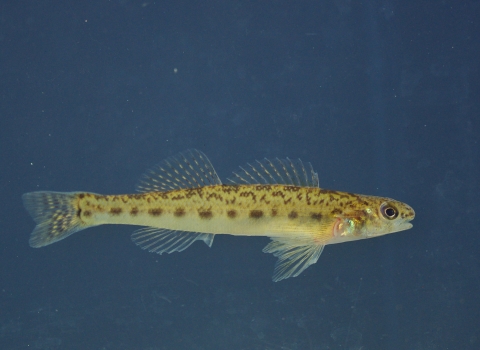The recovery plan is available for the pearl darter, a small fish listed as threatened under the Endangered Species Act. This plan includes bringing the pearl darter back to the Pearl River system where it has not been for 50 years.
“The main reason the pearl darter was listed as threatened was its extirpation from the Pearl River which greatly reduced the redundancy of the species and confined it to a single drainage,” said Fish and Wildlife Biologist Matt Wagner. “Successful reintroduction into the Pearl River will help us recover the species,” he further added.
Wagner is the species lead for the pearl darter.
The pearl darter used to live in the Pascagoula River system of Mississippi, and the Pearl River system of Mississippi and Louisiana. Now the pearl darter only lives in the Pascagoula River system.
Private John Allen National Fish Hatchery successfully raised pearl darters and has had three successful spawns since 2018. With a controlled propagation and introduction plan, the Service will work with private landowners and its partners to bring the pearl darter back to the Pearl River system.
The recovery plan also includes monitoring, surveying and research of the species. The goal of the recovery plan is to ensure it can survive long-term in both the Pascagoula and Pearl River systems to the point that it is no longer threatened.
A draft recovery plan was made available in February 2022 as a part of a transparent process to include the public. The Service received no comments on the plan and has now finalized the plan with no changes.
The Service listed the pearl darter as threatened in 2017 along with a 4(d) rule to provide for conservation of the species. The pearl darter suffers from population declines due to poor water quality and degraded stream and river channels. Pollution from runoff and wastewater from treatment plants and industrial sites continue to affect the pearl darter’s remaining habitats.
With low population numbers, the pearl darter only lives in a few places. Remaining populations have low genetic diversity making them more vulnerable to drought, storms, and chemical spills.
The recovery plan is available for download at the following websites:
https://www.fws.gov/program/recovery/recovery-plans
https://www.fws.gov/office/mississippi-ecological-services
For a mailed copy, send a request to the U.S. Fish and Wildlife Service, Mississippi Ecological Services Field Office, 6578 Dogwood View Pkwy, Jackson, MS 39213, or by phone: 601-965-4900.
The mission of the U.S. Fish and Wildlife Service is working with others to conserve, protect, and enhance fish, wildlife, plants, and their habitats for the continuing benefit of the American people. For more information on our work and the people who make it happen, visit www.fws.gov. Connect with our Facebook page at www.facebook.com/usfwssoutheast, follow our tweets at www.twitter.com/usfwssoutheast, watch our YouTube Channel at http://www.youtube.com/usfws and download photos from our Flickr page at http://www.flickr.com/photos/usfwssoutheast.



